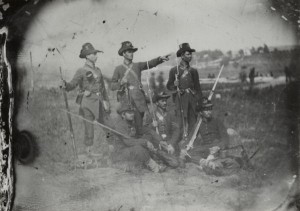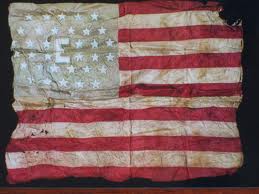 The spring of 1863 came to an Army of the Potomac in the midst of change. After taking command from General Burnside in late January, “Fighting Joe” Hooker spent the early days of the year rebuilding the army, both physically and mentally. Meals were improved, with more fresh food brought in daily. The paymasters got everyone up to date on their pay, removing the burden of worrying about providing financially for those back home.
The spring of 1863 came to an Army of the Potomac in the midst of change. After taking command from General Burnside in late January, “Fighting Joe” Hooker spent the early days of the year rebuilding the army, both physically and mentally. Meals were improved, with more fresh food brought in daily. The paymasters got everyone up to date on their pay, removing the burden of worrying about providing financially for those back home.
A new furlough system lessened desertions. Soldiers were granted extended leave to visit home, some for the first time since they’d enlisted more than two years prior. And as the furlough system lessened the number of men deserting, those that had already run were welcomed back. The last three weeks of March 1863 became an amnesty period, enacted by President Lincoln. Simply stated, anyone could return to their units by April 1st, no questions asked. While it’s difficult to put an exact number on the men who took advantage of this amnesty, several officers reported that the army must have had thousands of wayward soldiers return to bolster the ranks.
Other changes weren’t so welcome. March 30th saw the outlawing of all sutlers selling or gifting alcohol in the camps. While some credit this and the removal of the US Navy grog rations the previous summer on a new religious movement sweeping the country (hard to justify as many 19th Indiana soldiers commented on how little used the unit’s chapel was that winter), mostly it was to curb unruly drunken behavior that came from idly sitting in camp.
The spring campaign started in late April with the battle of Chancellorsville. The Iron Brigade and other units separated from the main army and moved as a diversion against the rebel forces still entrenched at Fredericksburg. On April 29th the unit came to Fitzhugh Crossing, only to find that the engineers had been unable to erect a bridge for crossing the Rappahannock River due to enemy soldiers on the opposite shore. After waiting the better part of a day for the engineers to complete their work while under enemy fire, General Hooker sent word for the army to cross “at all hazards”. What followed was one of the only amphibious operations of the Civil War.
While under heavy rifle fire from the Confederate rifle pits on the opposite shore, the members of the brigade ran for the water, piling into boats with whoever was already there, and pulled for the opposite bank as bullets skipped across the water so that “the water fairly boiled”, and smacked into boats and bodies. During the crossing, those left behind kept up a heavy fire on the Confederate positions, but even with this added help, the oarsmen had to huddle for cover several times, and in more than one boat the soldiers stood up in the rocking wooden boats and fire a volley to suppress the enemy fire. Once the first soldiers reached the opposite shore and began to swarm across the bank and up the rise towards the enemy rifle pits, the Confederate soldiers, surprised by the quickness and boldness of the crossing, turned and ran. The rout happened so quickly that some members of the 6th Wisconsin in the lead of the charge were hit by friendly fire as they crested the enemy ridge.
The first of May found the Iron Brigade digging in and applying pressure to the Confederates around Fredericksburg, as the rest of the army moved towards Chancellorsville in the west. On May 2nd, though, they were ordered to move and follow the main army. They re-crossed the river at the same point, this time over a pontoon bridge the engineers had been finally able to build. During the marched west they could hear the fighting around Chancellorsville. “I never in all my life heard such firing”, one of the men wrote. They arrived on the battlefield after Stonewall Jackson’s famous sneak attack had crushed the right flank of the Union army, and as the fighting moved off to the east and out of their sector, the Iron Brigade once again dug entrenchments. The brigade held their position until May 6th, but never once was directly engaged, only at long range by cannon on one or two brief occasions.
By May 7th the battle at Chancellorsville was over and the Iron Brigade retreated with the rest of the army under the cover of darkness. As they marched along, units familiar with their reputation cheered the men in the tall black hats, but many of the famed unit felt they “hadn’t done nothing to deserve any cheers” at Chancellorsville and Fredericksburg, and indeed felt cheated that the army retreated before they and the rest of the reserves were even put into the fight. The brigade hadn’t been heavily engaged since Antietam, and some began to feel as if they weren’t doing their part to end the war. Little did they know that their most important contribution to the war lay less than two months in their future, and how their actions on July 1st 1863 at Gettysburg would save the army’s position at a most critical juncture, would cement their legend in history, and nearly wipe them out in the process.